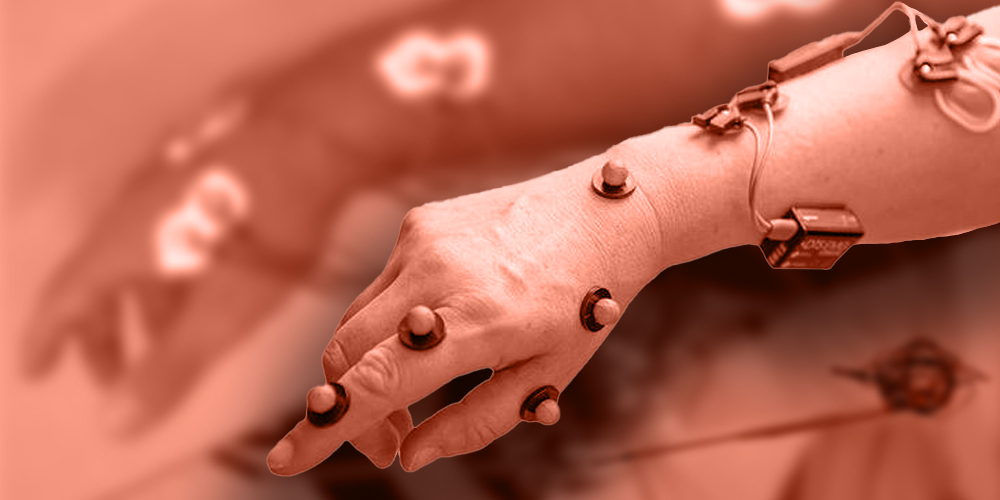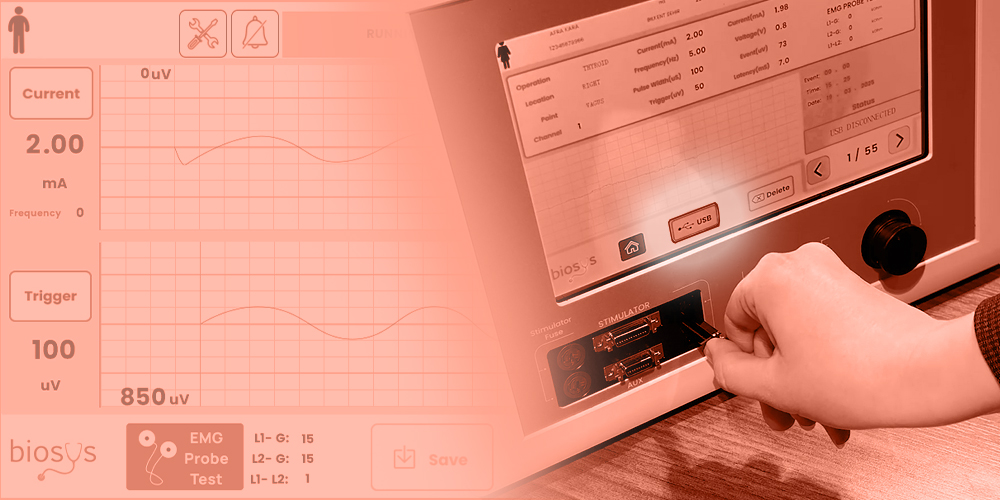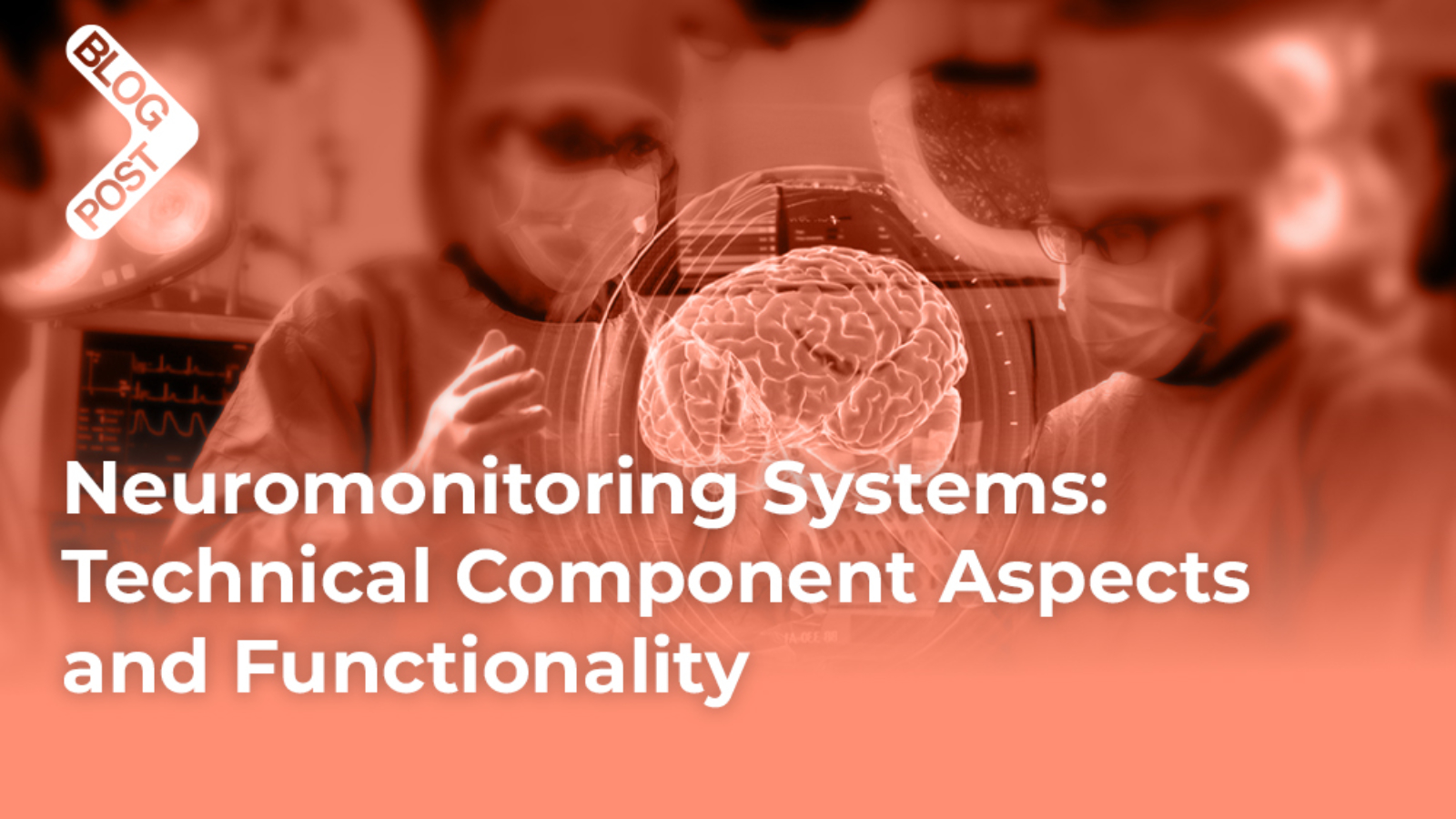A neuromonitoring system (neuromonitor) is a sophisticated medical device designed to assess the integrity and functionality of the nervous system in real-time.
It consists of several interdependent technical components that work in harmony to detect, amplify, process, and interpret neural signals during surgical procedures, critical care, and diagnostic evaluations.
The core elements of a neuromonitoring system can be categorized into hardware, software, and user interfaces, each contributing to the accuracy, reliability, and clinical utility of the system.
Understanding these components is crucial to appreciating how neuromonitoring enhances patient safety and surgical precision.
Main Parts of a Neuromonitoring System
- Electrodes & Sensors (Signal Detection)
- EEG Electrodes:
- Detect brain electrical activity, usually placed on the scalp.
- Types: Scalp electrodes, Depth electrodes (for invasive monitoring).
- EMG Electrodes (Electromyography):
- Measure muscle activity to evaluate nerve integrity.
- Typically used for monitoring cranial nerves and peripheral nerves.
- SSEP Electrodes (Somatosensory Evoked Potentials):
- Assess sensory pathway integrity by recording neural responses to sensory stimulation (e.g., electrical, tactile).
- Often used in spinal surgeries.
- MEP Electrodes (Motor Evoked Potentials):
- Monitor motor pathway integrity by detecting muscle responses following nerve stimulation.
- Essential in procedures where motor nerve function is at risk.
- Near-Infrared Spectroscopy (NIRS):
- Measures brain oxygenation levels non-invasively.
- Commonly used in ICU settings and brain surgeries.
- Intracranial Pressure (ICP) Sensors:
- Monitor pressure within the skull, especially important in trauma or brain injury management.
- EEG Electrodes:
- Stimulators (Signal Generation)
- Electrical Stimulators:
- Provide precise electrical pulses to stimulate nerves for evoked potential monitoring (MEPs, SSEPs).
- Can be surface-based or needle-based depending on application.
- Transcranial Magnetic Stimulators (TMS):
- Non-invasive method of stimulating cortical motor areas.
- Useful in mapping functional brain areas during surgery.
- Electrical Stimulators:
- Signal Amplifiers (Signal Processing)
- High-Gain Amplifiers:
- Boost weak neural signals to measurable levels without distortion.
- Essential for processing EEG, EMG, SSEP, and MEP signals.
- Noise Filters:
- Digital and analog filters used to reduce background noise from muscle movement, eye blinks, or other interferences.
- High-Gain Amplifiers:
- Data Acquisition System (Interface)
- Converts analog signals from electrodes into digital signals for further processing.
- Usually connected to a computer or monitoring device via a specialized interface card.
- Computer System & Software (Data Analysis)
- Signal Analysis Software:
- Processes and interprets signals in real-time.
- Provides visual displays (e.g., waveforms, brain mapping) for immediate feedback.
- AI-Based Algorithms (Optional):
- Advanced systems may use machine learning for pattern recognition to detect anomalies such as ischemia or seizures.
- User Interface:
- Touchscreen panels, monitors, or remote control systems for data visualization and control.
- Signal Analysis Software:
- Display & Alert System (Output)
- Real-Time Monitoring Displays:
- Visual representation of neural signals in various formats (waveforms, 3D mapping, etc.).
- Audio & Visual Alerts:
- Provide immediate feedback when signal thresholds exceed safety limits, enabling prompt intervention.
- Real-Time Monitoring Displays:
- Data Storage & Communication (Optional)
- Systems may include cloud-based storage or network integration for remote monitoring and data sharing.
- Useful in research, telemedicine applications, and postoperative monitoring.
Parts You’ll Need to Build a Basic Neuromonitoring System
- Signal Acquisition Devices: EEG, EMG, MEP, SSEP, NIRS, ICP sensors.
- Signal Stimulators: Electrical or magnetic stimulators.
- Amplification System: High-gain amplifiers and noise filters.
- Data Acquisition Hardware: Analog-to-digital converters (ADCs) and interface cards.
- Software Platform: Signal analysis tools, machine learning modules (if needed).
- Display and Alert System: Visual interface, alarms, and feedback systems.
- Communication Module (Optional): Cloud storage or remote monitoring software.

Assembling a Fully Functional Neuromonitoring System
Building a neuromonitoring system from components requires a combination of hardware, software, and signal processing tools. Below is a step-by-step guide to assembling a basic yet effective system, followed by a cost and availability comparison.
Step 1: Gather Essential Components
- Signal Acquisition Devices (Sensors & Electrodes)
- EEG Electrodes (scalp and depth electrodes) – Cost: $50 – $200 per set
- EMG Electrodes (surface and needle) – Cost: $30 – $100 per pair
- SSEP and MEP Electrodes – Cost: $100 – $300 per set
- NIRS Sensors (Near-Infrared Spectroscopy) – Cost: $500 – $1,500 per sensor
- ICP Sensors (Intracranial Pressure) – Cost: $1,000 – $3,000 each
- Signal Stimulators
- Electrical Stimulators (for EMG and SSEP) – Cost: $1,000 – $5,000
- Magnetic Stimulators (TMS) – Cost: $10,000 – $40,000
- Signal Processing Units
- High-Gain Amplifiers – Cost: $500 – $2,000 per channel
- Noise Filters – Cost: $100 – $500 each
- Data Acquisition Unit (ADC Interface) – Cost: $2,000 – $5,000
- Computer System
- High-Performance PC or Laptop – Cost: $1,000 – $3,000
- Graphical Processing Unit (GPU) for AI-enhanced processing – Cost: $500 – $1,500
- Signal Processing Software
- Open-Source Options: EEGLAB (free), OpenVibe (free)
- Commercial Options: Cadwell Cascade Software ($10,000 – $30,000), Medtronic Software Suite ($20,000 – $50,000)
- Display and Monitoring Interface
- Touchscreen Monitor – Cost: $300 – $1,000
- Real-Time Display and Alert Systems – Cost: Integrated with software
- Power Supply and Backup
- Uninterruptible Power Supply (UPS) – Cost: $200 – $1,000
Step 2: Assembly Process
- Electrode Placement
- Position the electrodes according to the surgical site or monitoring area:
- EEG Electrodes: Scalp positioning based on the 10-20 system.
- EMG Electrodes: Over muscles innervated by the target nerve.
- SSEP and MEP Electrodes: Near nerve stimulation points or target muscles.
- Secure with adhesive pads or clips.
- Position the electrodes according to the surgical site or monitoring area:
- Signal Processing Unit Setup
- Connect electrodes to the signal amplifier and noise filters.
- Route the amplified signals to the Data Acquisition Unit (ADC).
- Computer and Software Configuration
- Install signal analysis software.
- Configure signal processing settings (e.g., filtering frequency, gain control).
- Calibrate the system by testing signal integrity and noise levels.
- Signal Stimulation and Testing
- Connect electrical or magnetic stimulators to designated ports.
- Run test stimulations to check signal quality and response patterns.
- Display and Alert System Configuration
- Set up real-time waveform displays and configure alert thresholds.
- Integrate with audio and visual alert systems for critical changes.
Cost and Availability Comparison
| Component | Typical Cost Range | Availability |
| EEG Electrodes | $50 – $200 per set | Easily available from medical suppliers |
| EMG Electrodes | $30 – $100 per pair | Widely available |
| SSEP and MEP Electrodes | $100 – $300 per set | Available for medical and research use |
| Electrical Stimulators | $1,000 – $5,000 | Available through medical equipment vendors |
| Magnetic Stimulators (TMS) | $10,000 – $40,000 | Specialized vendors and medical suppliers |
| High-Gain Amplifiers | $500 – $2,000 | Commonly available |
| Data Acquisition Unit (ADC) | $2,000 – $5,000 | Easily available |
| Signal Processing Software | Free – $50,000 | Open-source and commercial options |
| Computer & GPU | $1,000 – $3,000 | Widely available |
| Touchscreen Monitor | $300 – $1,000 | Widely available |
| UPS Power Backup | $200 – $1,000 | Widely available |
Estimated Total Cost
- Basic Setup (Open-Source Software): $5,000 – $15,000
- Advanced Setup (Commercial Software): $30,000 – $100,000
- Premium Setup (Full AI and TMS Integration): $100,000 – $200,000

Parts That Need Replacement or Reprocessing After Each Surgery
| Component | Reuse Status | Reason for Replacement or Reprocessing |
| EEG Electrodes (Scalp) | Reusable or Disposable | Reusable if made of silver/silver chloride (Ag/AgCl); requires cleaning and sterilization. Disposable gel-based electrodes are single-use. |
| Depth Electrodes (EEG) | Disposable | Used for invasive monitoring; cannot be sterilized effectively and are single-use only. |
| EMG Electrodes (Surface) | Reusable or Disposable | Surface electrodes are often disposable but reusable types need cleaning and sterilization. |
| EMG Electrodes (Needle) | Disposable | Needles are single-use to prevent infection and ensure patient safety. |
| SSEP & MEP Electrodes | Reusable or Disposable | Reusable types need proper cleaning and sterilization. Adhesive or needle electrodes are often disposable. |
| NIRS Sensors (Near-Infrared Spectroscopy) | Reusable | Typically reusable but must be cleaned after each use. |
| ICP Sensors (Intracranial Pressure) | Disposable or Reusable | Reusable sensors require proper sterilization, but most are designed for single-use only. |
| Electrical Stimulators | Reusable | No replacement needed, but calibration and inspection are required periodically. |
| Magnetic Stimulators (TMS) | Reusable | No replacement needed, but safety testing is recommended regularly. |
| Signal Amplifiers & Filters | Reusable | No replacement needed, but routine maintenance and calibration are necessary. |
| Data Acquisition Unit (ADC) | Reusable | No replacement needed, but software updates and hardware maintenance are required. |
| Computers & Software | Reusable | No replacement needed, but regular updates and security checks are essential. |
| Touchscreen Monitors | Reusable | No replacement needed, but cleaning and maintenance are required. |
Components That Are Typically Single-Use (Disposable)
- Needle Electrodes (EMG, MEP, SSEP):
- Risk of infection makes them unsuitable for sterilization.
- Cost per electrode: $5 – $20 each.
- Adhesive Electrodes (EMG, SSEP):
- Adhesive degrades after use, making them impractical for sterilization.
- Cost per set: $10 – $50.
- Depth Electrodes (EEG):
- Invasive nature prevents effective sterilization.
- Cost per electrode: $100 – $500.
Components That Are Reusable (With Sterilization)
- Scalp Electrodes (EEG):
- Reusable if made of high-quality materials (e.g., silver/silver chloride).
- Sterilization Method: Autoclaving or chemical disinfection.
- Lifespan: Up to several months with proper care.
- Surface Electrodes (EMG):
- Reusable types require cleaning with disinfectant solutions.
- Lifespan: Multiple uses if maintained properly.
- NIRS Sensors:
- Clean with alcohol-based disinfectants.
- Lifespan: Varies with usage frequency and handling care.
- ICP Sensors (Reusable Types):
- Rarely reusable but can be sterilized if specified by the manufacturer.
- Check manufacturer guidelines for sterilization procedures.
Maintenance Requirements (Post-Surgery)
- Signal Amplifiers & Filters:
- Regular calibration and cleaning of contact points.
- Cost of maintenance: $100 – $500 annually.
- Data Acquisition Unit & Software:
- Update firmware and software as recommended.
- Cost of software maintenance: Free (open-source) to $1,000 per year (commercial software).
- Computers & Displays:
- Routine cleaning and hardware diagnostics.
- Cost of maintenance: $100 – $300 per year.

